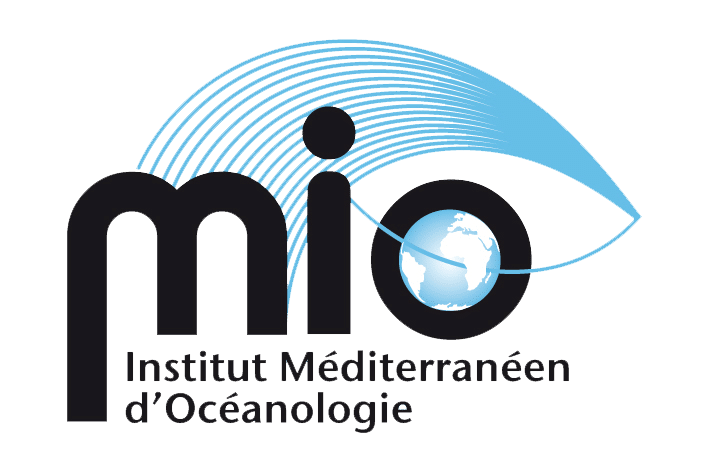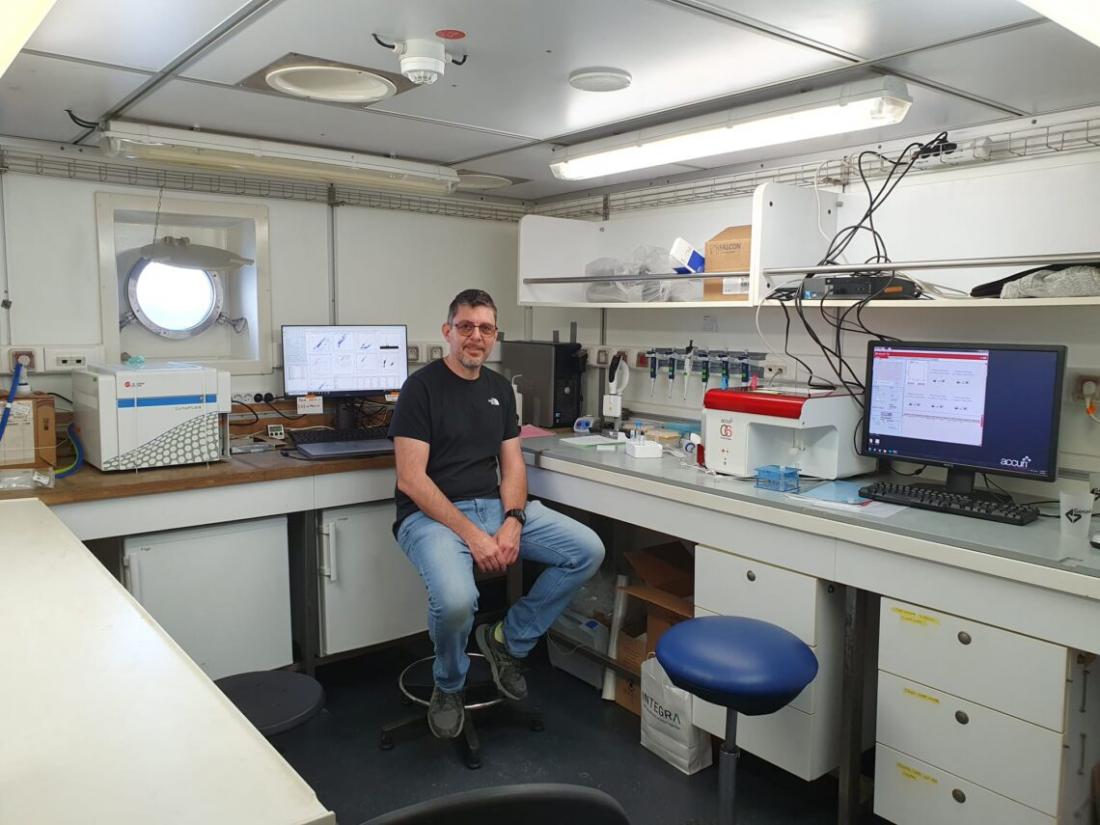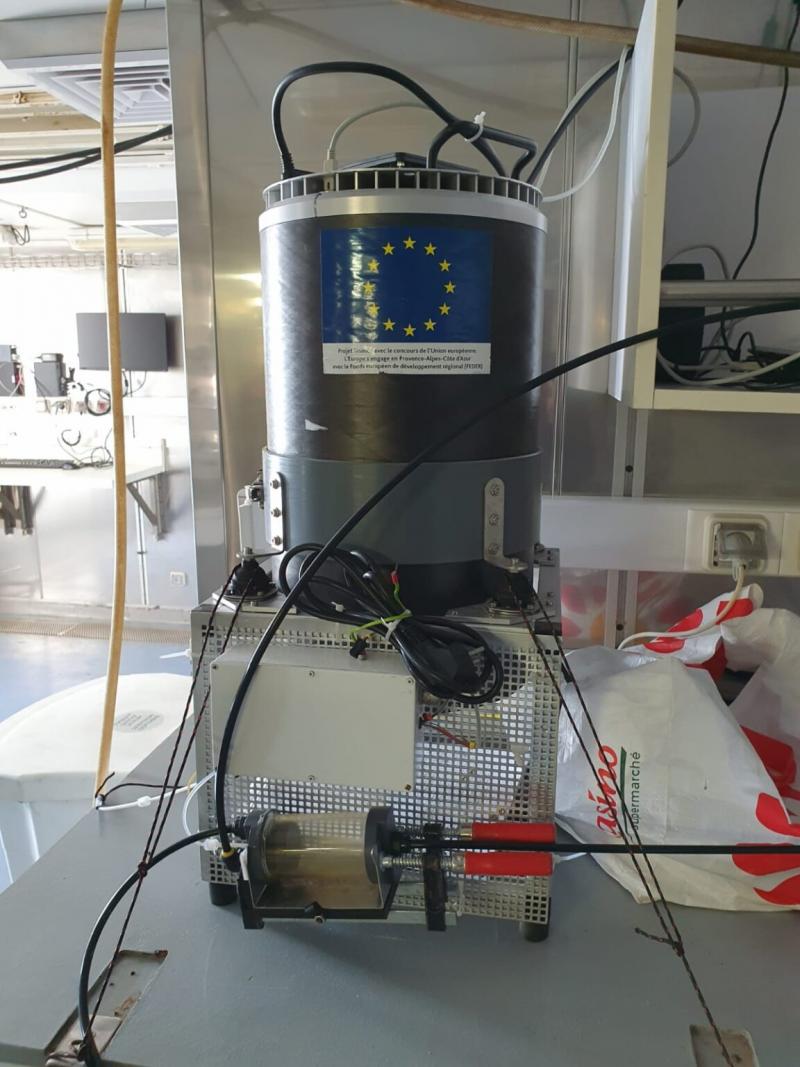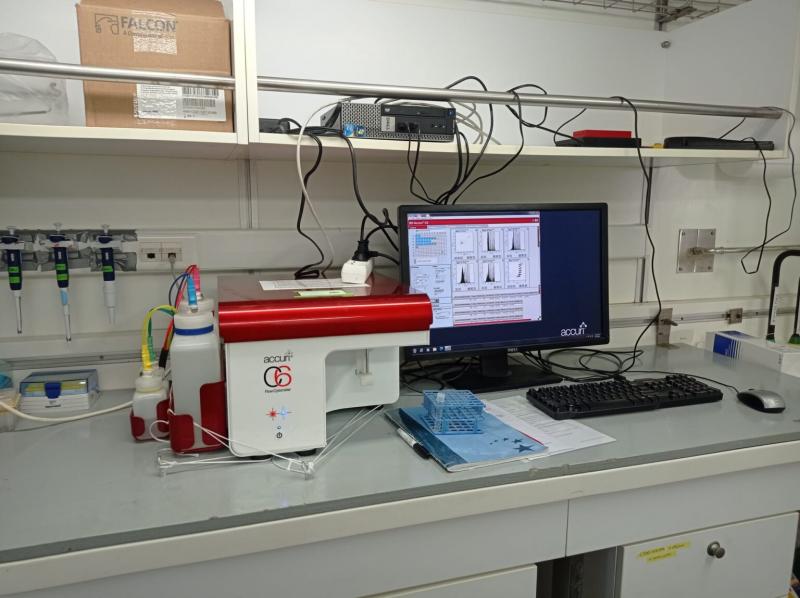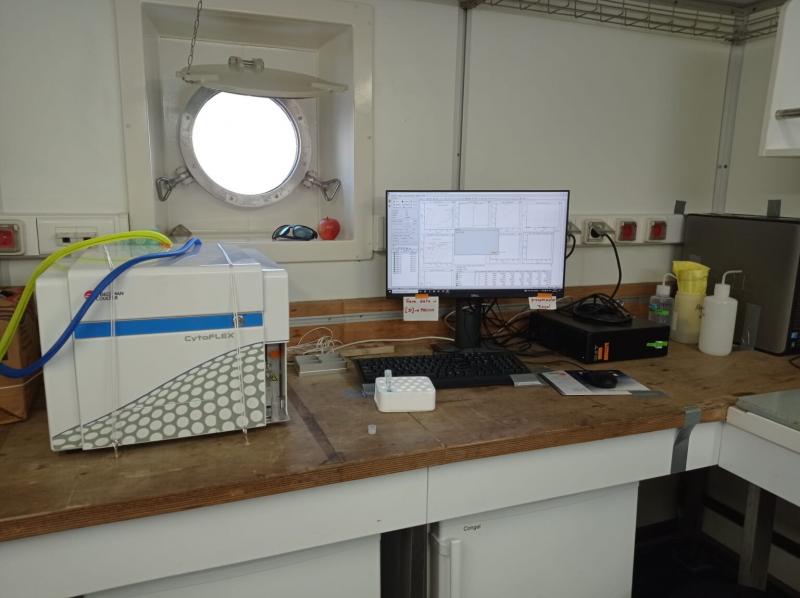Find out what drives the diversity and distribution of plankton in the Mediterranean Sea
Gérald Grégori, scientific co-leader of BioSWOT-Med, describes the campaign's sampling strategy and how it will gather data to study the drivers of plankton diversity and distribution in the Mediterranean Sea by studying small-scale features such as filaments or small eddies. Even if these structures are weak and short-lived (a few days), they can have a strong influence on the microbial community.
Gérald Grégori, scientific co-leader of BioSWOT-Med, in the laboratory on board the R/V L'Atalante.
RESEARCH THEMES - Gérald Grégori is a researcher with the CNRS (Centre National de la Recherche Scientifique), at the Institut Méditerranéen d'Océanographie in Marseille (France). His research focuses on marine planktonic microbes and their relationship with the ecosystem and biogeochemistry. To do this, he studies the factors that influence their abundance and distribution along the water column, in different locations such as the coast or the open ocean. The originality of this research lies in the use of single-cell analysis to study them, both in situ and in the laboratory, with a particular emphasis on flow cytometry. As part of the BioSWOT-Med campaign, he is the chief scientist for biology.
What are the main research themes that will be addressed during the campaign?
The themes to be addressed during the campaign are designed to reveal the driving forces behind the diversity and distribution of plankton in the western Mediterranean. Why the western Mediterranean? Because this region combines a high diversity of plankton, a low concentration of nutrients and weak ocean circulation. We believe that small-scale features such as filaments or small eddies, even if they are weak and short-lived (a few days), can strongly influence the microbial community.
During the BIOSWOT-Med campaign, we plan to follow the temporal evolution of these fine-scale structures above the western Mediterranean crossroads generated by the tracks of the new SWOT satellite, equipped with a new generation of instruments. The new Ka-band radar interferometer (KaRIn) will measure sea level with unprecedented resolution and help us to better identify, define and describe the small-scale features encountered in situ.
During the BioSWOT-Med campaign, we aim to characterise the physical-biogeochemical coupling in these fine-scale structures using an adaptive Lagrangian sampling strategy. To implement this Lagrangian strategy, we will use the SPASSO software (Software Package for an Adaptive Satellite-based Sampling for Oceanographic cruises) developed in our group and applied in several research campaigns. The physical information collected using a range of instruments (drifters and CTDs, Moving Vessel Profiler MVP, satellite, and numerical models) will be combined with a huge set of biological data collected by a multi-sensor characterisation of the plankton community. We will combine flow cytometry analyses, imaging, and advanced molecular techniques (meta-transcriptomics, metagenomics and meta-barcoding), with the use of autonomous and robotic platforms deployed in situ or in the laboratory. The aim is to obtain a more complete picture of the distribution and dynamics of the various compartments of the first levels of the food web, and to define the relationships between them and with hydrological (nutrients, temperature, salinity) and physical (horizontal currents, vertical velocities, etc.) factors.
In the BioSWOT-Med campaign, you are responsible for microbiology. Can you explain what microbiology is and why it's important to study it?
In a teaspoon of seawater, there are millions, even hundreds of millions of organisms: viruses, archaea, bacteria and eukaryotes. Are they dangerous?
No !
All these organisms are natural hosts of seawater. They are even essential to the plankton machinery. Without this machinery, we would not eat fish, water infected with organic waste would be unfit for swimming and, what's more, humans would probably not exist. Phytoplankton organisms are microscopic, invisible and seemingly insignificant. And yet they are. Plant plankton is capable of transforming the invisible (dissolved carbon dioxide or CO2), the mineral (nutrient salts - nitrates, phosphates, silicates) and the immaterial (light) into organic matter. Like land plants, it is at the origin of a miracle: creating life, organic matter, from inert mineral matter thanks to the light energy provided by the sun. This process is called photosynthesis. Organisms capable of producing organic matter from mineral matter and energy are called autotrophs.
Phytoplankton forms the basis of the marine food web. It is a highly complex network that starts with phytoplankton, passes through zooplankton (phytoplankton consumers and small carnivores) and extends to top predators (such as fish, dolphins, etc. and humans). It is estimated that it takes one tonne of phytoplankton to produce 100g of fish flesh. Phytoplankton cells can also precipitate to the bottom of the sea after their death and become incorporated into sediments, trapping the carbon they have contained over geological time. Did you know that they are one of the sources of oil? Finally, they can also be 'recycled' back into the water column by bacteria. Phytoplankton organisms are tiny and their biomass (mass of living matter) does not exceed 2 % of the planet's plant biomass (sea and land combined). But they are responsible for almost half of our planet's primary production. In fact, half of the oxygen we breathe comes from phytoplankton. Without the presence of phytoplankton in the oceans, the CO2 content of the atmosphere would be around 600 ppm (parts per million) instead of the current 400 ppm, which would be equivalent to an additional increase in the average temperature of our planet of 1°C.
Phytoplankton is not the only compartment of plankton. Heterotrophic prokaryotes, more commonly known as bacteria and archaea, represent the greatest source of as yet unknown biodiversity on the planet. Unlike eukaryotic cells, these tiny cells have no nucleus. Most of these bacteria, and all the archaea, are heterotrophic: they do not photosynthesise and (like us) need organic matter to feed themselves. It is often dead, dissolved or particulate organic matter that they degrade and recycle. Bacteria and archaea are therefore the essential 'garbage collectors' of plankton.
Not all bacteria are heterotrophic. One group of photosynthetic bacteria plays a major role in phytoplankton: cyanobacteria (or "blue-green algae"). Some cyanobacteria are capable of fixing molecular nitrogen (N2), the gas that makes up most of the air we breathe, thus compensating for the lack of nutritive salts. Others simply photosynthesise, like Prochlorococcus and Synechococcus; they are very small (0.2 to 2 µm in diameter) but extraordinarily numerous: up to 100,000/millilitre.
Contact us: Tosca Ballerini
More information
Cytometers in the laboratory of the R/V L'Atalante.
